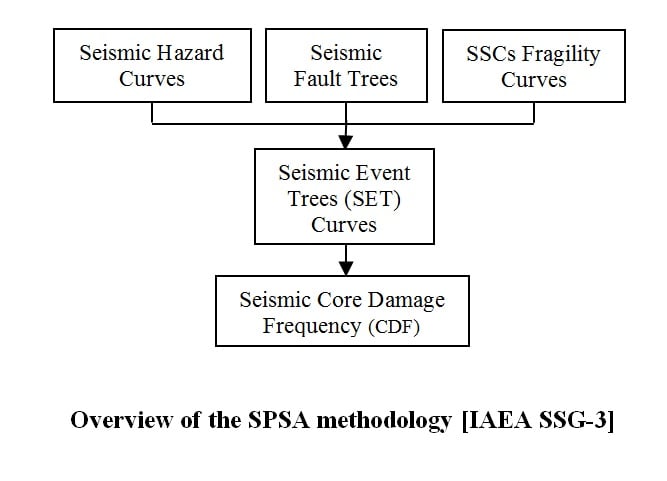Enhanced approach for CDF quantification in Seismic Probabilistic Safety Assessment of a Research Reactor
DOI:
https://doi.org/10.57056/ajet.v8i2.130Keywords:
Seismic PSA, Binary decision diagram, Rare Event Approximation, Min Cut Upper BoundAbstract
In Probabilistic Safety Analysis (PSA) applications, it is common practice to employ approximations with the expectation or assumption of a small overestimation in the quantification of the Core Damage Frequency (CDF). The overestimation of the CDF depends on the Minimal Cut Sets (MCS) structures and event probabilities but the amount of conservatism is generally unknown. Hence, when dealing with large and non-coherent fault trees, conventional approaches to model dependencies in event trees analysis using coherent approximations are shown to be inaccurate. The limitation of the techniques in terms of accuracy of the solutions becomes apparent. For instance, the quantification methods using Rare Event (REA) and Min Cut Upper Bound (MCUB) approximations valid in internal event PSA may result in excessively conservative results in Seismic PSA. Therefore, in order to calculate the accurate top event probability from a fault tree rather than improving the direct probability calculation from cut sets, the Binary Decision Diagram (BDD) is introduced for more exact quantification. BDD development highlights the effort to reduce the conservatism caused by RAE and MCUB computations. The analysis carried out in this work, within the Seismic Probabilistic Safety Assessment (SPSA) of a nuclear Research Reactor (RR) case study using BDD framework shows that the approach is feasible and effective in evaluating the seismic risk of core damage and provide reasonable assurance that related decisions on real-time risk status can be taken robustly and with confidence.
References
Jung WS. A method to improve cut set probability calculation in probabilistic safety assessment of nuclear power plants. Reliability Engineering and System Safety. 2015; 134: 134–142, https://doi.org/10.1016/j.ress.2014.10.019
Kim JS, and Kim MC. Insights gained from applying negate-down during quantification for seismic probabilistic safety assessment. Nuclear Engineering and Technology. 2022; 54: 2933-2940, https://doi.org/10.1016/j.net.2022.03.014
Ryu J and Jae M. A quantification methodology of Seismic Probabilistic Safety Assessment for Nuclear Power Plant. Annals of Nuclear Energy. 2021; 159: 108296, https://doi.org/10.1016/j.anucene.2021.108296
Kwag S and Gupta A. Probabilistic risk assessment framework for structural systems under multiple hazards using Bayesian statistics. Nuclear Engineering Design. 2017; 315: 20–34, https://doi.org/10.1016/j.nucengdes.2017.02.009
Kwag S. Probabilistic Approaches for Multi-Hazard Risk Assessment of Structures and Systems (Ph.D. thesis), North Carolina State University, Raleigh, NC, US. 2016.
SSG-9 (Rev. 1), Seismic Hazards in Site Evaluation for Nuclear Installations, IAEA Safety Standards, International Atomic Energy Agency Vienna, 2022.
Kennedy RP, Cornell CA, Campbell RD, Kaplan S, and Perla HF. Probabilistic seismic safety study of an existing nuclear power plant. Nuclear Engineering and Design. 1980; 59: 315–338.
Kennedy RP and Ravindra MK. Seismic Fragilities for Nuclear Power Plant Risk Studies. Nuclear Engineering and Design. 1984; 79: 47–68.
Ravindra MK and Tiong LW. Comparison of methods for seismic risk quantification. In: Transactions, 10th SMiRT, vol. 1989; 187–192.
Basu PC, Ravindra MK and Mihara Y. Component fragility for use in PSA of nuclear power plant. Nuclear Engineering and Design, 2017; 323: 209–227, http://dx.doi.org/10.1016/j.nucengdes.2016.10.018
Lo C K, Pedroni N and Zio E. Treating Uncertainties in a Nuclear Seismic Probabilistic Risk Assessment by Means of the Dempster-Shafer Theory of Evidence. Nuclear Engineering And Technology, Vol.46 No.1 February 2014. http://dx.doi.org/10.5516/Net.03.2014.701
Rauzy A. Binary Decision Diagrams for Reliability Studies. Handbook of Performability Engineering. 2008, 381-396,. ISBN 978-1-84800-130-5, http://dx.doi: 10.1007/978-1-84800-131-2_25
Bryant R. Graph Based Algorithms for Boolean Function Manipulation, IEEE Transactions on Computers.1986; 35(8): 677-691, http://dx.doi: 10.1109/TC.1986.1676819
Jung WS and et al. A Fast BDD Algorithm for Large Coherent Fault Trees Analysis. Reliability Engineering and System Safety. 2004; 83: 369-374, https://doi.org/10.1016/j.ress.2003.10.009
Rauzy A. New Algorithm for Fault Tree Analysis. Reliability Engineering and System Safety.1993; 40:203-211, https://doi.org/10.1016/0951-8320(93)90060-C
Kwag S., Oh J. and Lee J.M. Application of Bayesian statistics to seismic probabilistic safety assessment for research reactor. Nuclear Engineering and Design. 2018; 328: 166–181, https://doi.org/10.1016/j.nucengdes.2018.01.022
Xoubi N. Jordan Research and Training Reactor Utilization Facilities, Jordan Atomic Energy Commission (Jaec), Iaea-Tm-2010; 38728

Downloads
Published
How to Cite
Issue
Section
License
Copyright (c) 2023 Mohammed Boufenar, Djemai Merrouche

This work is licensed under a Creative Commons Attribution-NonCommercial 4.0 International License.





